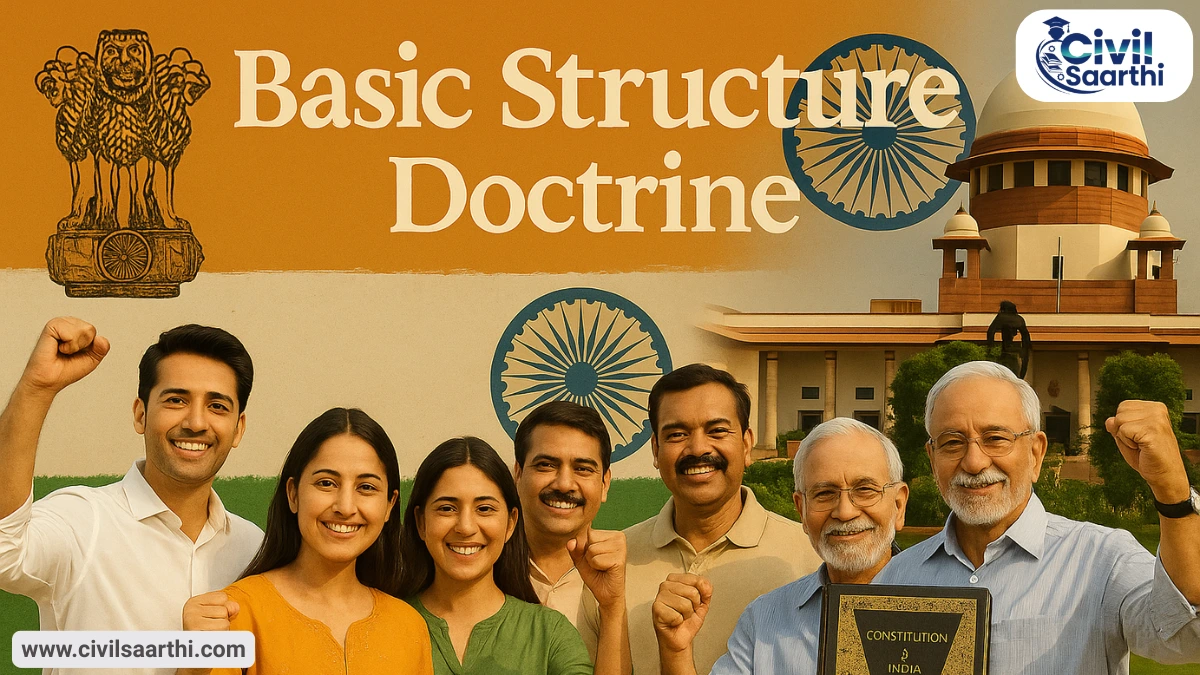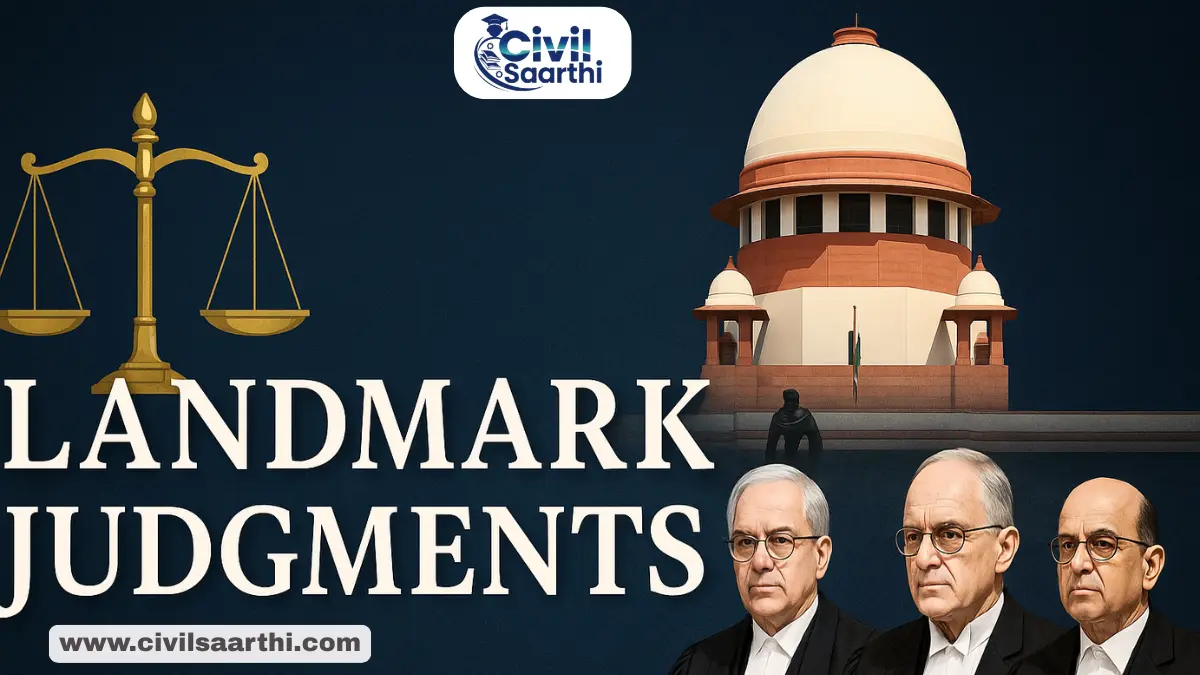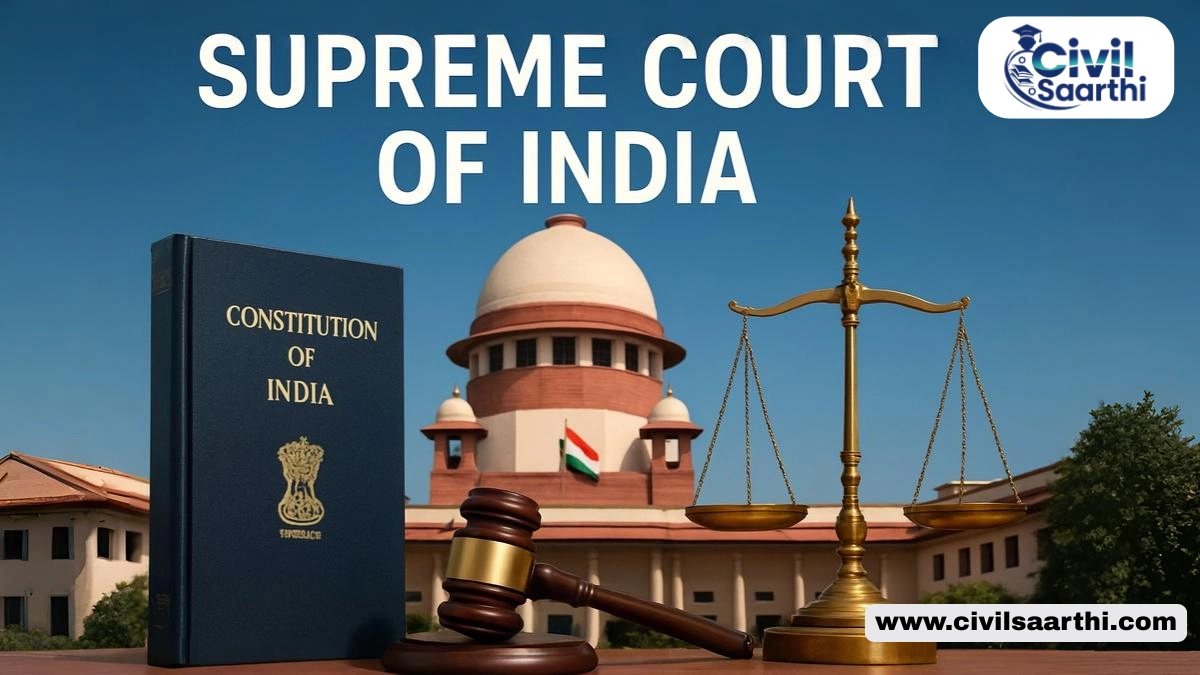The Basic Structure Doctrine is a judicially evolved principle that preserves the soul of the Indian Constitution. It restricts Parliament from altering essential constitutional features, ensuring continuity of democratic values. Introduced through landmark judgments, it serves as a critical check on legislative power.
Basic Structure Doctrine
The Basic Structure Doctrine is a cornerstone of Indian constitutional interpretation and plays a vital role in maintaining the supremacy of the Constitution while ensuring a balance between Parliamentary sovereignty and judicial review. This article explains the Basic Structure Doctrine in detail for UPSC aspirants, following the structure of reputed UPSC prep platforms (without mentioning their names), with unique but factually aligned content.
Basic Structure Doctrine Overview
The Basic Structure Doctrine prevents the Parliament from altering the fundamental identity of the Indian Constitution. This concept, which evolved through judicial interpretations, acts as a safeguard against authoritarian amendments. It protects essential constitutional features such as democracy, secularism, and federalism.
Basic Structure Doctrine Overview | |
| Topic | Description |
| Meaning | Limits to the amending power of Parliament |
| Evolution | Developed through landmark Supreme Court judgments |
| Key Cases | Kesavananda Bharati, Minerva Mills, Golaknath, etc. |
| Core Elements | Rule of law, judicial review, separation of powers, etc. |
| Significance | Ensures democracy and constitutional supremacy |
| Criticisms | Judicial overreach, ambiguity in interpretation |
Basic Structure Doctrine Meaning
The Basic Structure Doctrine Meaning refers to the principle that the Parliament, although empowered to amend the Constitution, cannot alter its fundamental framework or essential features. This doctrine ensures that certain core principles, like democracy, secularism, and the rule of law, remain inviolable even by constitutional amendments.
Basic Structure Doctrine Meaning | |
| Aspect | Details |
| Origin | Supreme Court of India |
| Based on | Interpretation of Article 368 |
| Purpose | Protect core constitutional principles |
| Key Principle | Parliament cannot destroy the basic framework of the Constitution |
| Safeguarded by | Judiciary, through review and interpretation |
Evolution of Basic Structure Doctrine
The journey began with the Shankari Prasad (1951) case, where the Court upheld Parliament’s unrestricted amending power. However, in Golaknath (1967), the Court reversed this view, ruling that fundamental rights could not be amended. This set the stage for Kesavananda Bharati (1973), where the doctrine was formally established.
Evolution of Basic Structure Doctrine | |
| Case Name | Contribution to the Doctrine |
| Shankari Prasad (1951) | Parliament can amend Fundamental Rights |
| Sajjan Singh (1965) | Reiterated Parliament’s supremacy |
| Golaknath (1967) | Denied power to amend Fundamental Rights |
| Kesavananda Bharati (1973) | Formally established Basic Structure Doctrine |
| Minerva Mills (1980) | Strengthened limits on Parliament’s power |
Basic Structure Doctrine Cases
The Basic Structure Doctrine Cases are crucial for understanding how Indian constitutional law evolved. These judgments mark pivotal moments where the judiciary asserted its role in safeguarding the Constitution. The Basic Structure Doctrine Cases should be memorized with dates and their key principles, especially for UPSC Mains and Prelims.
- Shankari Prasad v. Union of India (1951): The Supreme Court upheld Parliament’s power to amend Fundamental Rights under Article 368. It did not recognize any limitation on constitutional amendment powers.
- Sajjan Singh v. State of Rajasthan (1965): Reaffirmed Shankari Prasad and held that Parliament could amend any part of the Constitution. However, some judges expressed concern over unrestricted amendment power.
- Golaknath v. State of Punjab (1967): The Court ruled that Parliament cannot amend Fundamental Rights. Amendment was treated as “law” under Article 13(2), hence subject to judicial review.
- Kesavananda Bharati v. State of Kerala (1973): This landmark case introduced the Basic Structure Doctrine. Parliament can amend the Constitution but cannot alter its “basic structure.”
- Indira Nehru Gandhi v. Raj Narain (1975): Struck down Article 329A (inserted by the 39th Amendment) as violating basic structure. Upheld the supremacy of free and fair elections and judicial review.
- Minerva Mills v. Union of India (1980): Declared that harmony between Fundamental Rights and Directive Principles is part of the basic structure. Limited Parliament’s power to amend the Constitution under Article 368.
- Waman Rao v. Union of India (1981): Upheld the validity of laws added to the Ninth Schedule before Kesavananda Bharati. Laws inserted after 1973 are subject to basic structure test.
- S.P. Sampath Kumar v. Union of India (1987): Upheld the creation of administrative tribunals but emphasized judicial independence. Asserted that access to justice is part of the basic structure.
- L. Chandra Kumar v. Union of India (1997): Held that judicial review by High Courts and Supreme Court cannot be excluded. Struck down parts of the 42nd Amendment violating judicial review powers.
- I.R. Coelho v. State of Tamil Nadu (2007): Stated that any law inserted into the Ninth Schedule after 1973 is open to judicial review. Laws that damage the basic structure can be struck down.
- Ashok Kumar Thakur v. Union of India (2008) Affirmed reservation as a valid tool for social justice but subject to basic structure limits. Ensured that equality remains a guiding constitutional principle.
- National Judicial Appointments Commission (NJAC) Case (2015): Struck down the 99th Constitutional Amendment establishing NJAC. Held that judicial independence is part of the basic structure.
Elements of the Basic Structure
The Elements of the Basic Structure are not explicitly listed in the Constitution. They have been interpreted over time by the judiciary. These elements represent the soul of the Constitution and cannot be amended or removed by Parliament. The identification of these elements is flexible and dynamic, which allows the judiciary to respond to changing contexts.
- Supremacy of the Constitution
- Rule of Law
- Judicial Review
- Federalism
- Separation of Powers
- Free and Fair Elections
- Secularism
- Unity and Integrity of the Nation
- Sovereign, Democratic and Republic Nature of the Indian Polity
- Parliamentary System of Government
- Harmony and Balance between Fundamental Rights and Directive Principles
- Independence of the Judiciary
- Limited Power of Parliament to Amend the Constitution
- Welfare State
- Free and Independent Press
- Principle of Equality
- Effective Access to Justice
- Powers of the Supreme Court under Articles 32 and 136
- Powers of the High Courts under Articles 226 and 227
- Control of the Centre over the States in Emergency Provisions
Important Articles Associated with the Basic Structure Doctrine
Important Articles Associated with the Basic Structure Doctrine | ||
| Article | Subject | Relevance to Basic Structure Doctrine |
| Article 13 | Laws inconsistent with Fundamental Rights | Provides basis for judicial review; laws violating FRs are void. |
| Article 32 | Right to Constitutional Remedies (Supreme Court) | Ensures enforcement of Fundamental Rights; considered part of the basic structure. |
| Article 226 | Writ Jurisdiction of High Courts | Empowers High Courts to protect FRs and legal rights; essential for judicial independence. |
| Article 368 | Power to Amend the Constitution | Procedure for constitutional amendments; subject to limits imposed by the basic structure doctrine. |
| Article 14 | Equality Before Law | Guarantees the right to equality; fundamental to rule of law and democracy. |
| Article 19 | Protection of Freedoms | Ensures freedoms like speech, movement, and assembly; core to democratic governance. |
| Article 21 | Right to Life and Personal Liberty | Guarantees human dignity and liberty; a cornerstone of constitutional values. |
| Article 50 | Separation of Judiciary from Executive | Part of DPSPs; supports judicial independence—an essential feature of the basic structure. |
| Article 131 | Original Jurisdiction of the Supreme Court | Enables Centre-State dispute resolution; supports federalism under the Constitution. |
| Article 136 | Special Leave Petition (SLP) | Grants wide appellate power to the Supreme Court; essential to the Court’s role as constitutional guardian. |
| Preamble | Constitutional Ideals | Lays out the basic philosophy: justice, liberty, equality, fraternity, interpreted as part of basic structure. |
Significance of the Basic Structure Doctrine
The Significance of the Basic Structure Doctrine lies in its role as the ultimate protector of India’s constitutional democracy. It ensures that the spirit of the Constitution is maintained, even when political powers shift or Parliamentary majorities change. By restricting Parliament’s ability to alter fundamental principles, this doctrine acts as a constitutional safeguard.
Significance of the Basic Structure Doctrine | |
| Significance Point | Explanation |
| Constitutional Supremacy | Prevents authoritarian changes |
| Judicial Independence | Protects the role of the judiciary |
| Balanced Governance | Maintains separation of powers |
| Protection of Fundamental Rights | Ensures rights are not diluted by amendments |
| Federal Integrity | Prevents centralization of power |
Basic Structure Doctrine Criticism
Despite its protective role, the Basic Structure Doctrine Criticism stems from concerns about judicial overreach and vagueness. Critics argue that the doctrine gives unelected judges the power to override Parliament’s decisions, leading to a conflict between democracy and judicial authority. Yet, proponents argue that such flexibility allows the Constitution to be interpreted according to changing times.
Basic Structure Doctrine Criticism | |
| Criticism | Description |
| Judicial Overreach | Judiciary deciding on matters of legislation |
| Lack of Clarity | No definitive list of “basic features” |
| Democratic Paradox | Unelected body limiting the will of elected representatives |
| Ambiguity in Interpretation | Wide scope for subjective interpretations |
| Potential for Misuse | Can be used to nullify valid constitutional changes |
Conclusion: Significance in Constitutional Governance
The Basic Structure Doctrine acts as a constitutional safeguard that preserves the identity and integrity of the Indian Constitution. It ensures that even while allowing for change through amendments, the foundational principles, like rule of law, judicial review, federalism, and democracy, remain untouched.
Basic Structure Doctrine FAQs
What is the Basic Structure Doctrine in simple words?
The Basic Structure Doctrine means that some parts of the Constitution are so essential that Parliament cannot change or remove them, even through amendments.
Who introduced the Basic Structure Doctrine in India?
It was introduced by the Supreme Court in the Kesavananda Bharati Case (1973).
Is the Basic Structure Doctrine mentioned in the Constitution?
No, it is not mentioned explicitly. It was developed by the judiciary through constitutional interpretation.
Why is the Basic Structure Doctrine important?
It ensures that the Constitution retains its core identity and protects democracy and fundamental rights.
Can the Basic Structure Doctrine be amended?
No. The doctrine restricts Parliament from amending the basic features of the Constitution.
What are examples of elements in the Basic Structure?
Judicial review, secularism, rule of law, and free and fair elections are some examples.
What are criticisms of the Basic Structure Doctrine?
Critics argue it causes judicial overreach and creates ambiguity due to the absence of a clear definition.







